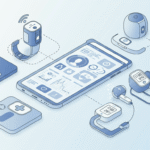EXCLUSIVE POST – Does your surgeon actually stand by the operating room table anymore? Is there a scrub nurse present? What about the surgeon’s hand tremor and his low back pain – will they impact your surgery? Will your medications be accurately selected and prepared? On Sunday, will your physician bother to visit you in the hospital?
EXCLUSIVE POST – Does your surgeon actually stand by the operating room table anymore? Is there a scrub nurse present? What about the surgeon’s hand tremor and his low back pain – will they impact your surgery? Will your medications be accurately selected and prepared? On Sunday, will your physician bother to visit you in the hospital?
Robotics has the potential to revolutionize the delivery of healthcare. It can help extend the delivery of information, expertise and clinical care across time and geographical space barriers. Robotics offers the opportunity to enhance quality of care through extension of clinical expertise and leveraging of integrated datasets and best practices. It can be used across the continuum–from the hospital setting (e.g. OR, ER, etc.) into primary care offices and even into the home. And, robotics offers opportunities for telementoring, training, and education using a combination of robotics and telemedicine. Here are some of the major uses of robotics in clinical medicine today.
Robotic Surgery
Only one surgical robot is currently commercially available – daVinci. It has found wide interest and acceptance by many surgeons especially for prostate surgery, cardiac surgery and gynecologic surgery. Most institutions indicate that the combination of initial price, annual maintenance fees, training time, and other costs make for either a very long pay back time or, more often, never achieving a return on the investment. Truth is that many hospitals purchased their robot as a marketing ploy and it sits idle in the corner much of the time – not good medicine since it needs to be used extensively, some argue as much as 100’s of times, for a surgeon to be really competent. Otherwise, better to do the surgery the old fashioned way.
However, the promise of robotic surgery includes a number of advantages. Among them are leveraging the particular strengths of computers such as tremor- filtered precision (i.e., it removes the surgeons hand tremor) and repeatability to enhance the capability of the average surgeon. It can import data from imaging devices and others devices in the operating room for information augmentation. It can reduce the occupational environment hazard for surgeons by removing the surgeon (and other OR personnel) from biohazards, for example, radiation exposure since the surgeon sits at a console some distance from the patient. It can enable extension of surgical care into geographically remote areas via telesurgery, including battlefield situations for the military. It is indefatigable, that is it does not get tired by a long procedure and does not develop back pain from leaning over the operative site. The surgeon can set pre-specified ‘no fly zones’ -protective algorithms can be inserted into the software to prohibit undesirable motion such as getting too close to a critical nerve during prostate surgery.
Combined, these attributes allow for integrating patient specific data before and during the procedure; allowing for less invasive surgery as with coronary artery bypass surgery; more accurate surgery such as with craniotomies; the ability to pre-plan and rehearse surgery or at least certain complex segments of the planned surgery; and it can have the advantage of built-in alerts and detectors. But it is no panacea.
Robotic Surgical Scrub Assistant
“Penelope” has been developed at Columbia University by general surgeon Dr Michael Treat with funding from the US Army’s Telemedicine and Technology Research Center, in Fort Detrick MD. Penelope has four fundamental parts: A robotic arm with an electromagnetic gripper that can select instruments from the back tray and arrange them on the stand and then hand them to the surgeon on demand; the instrument platform which is a set of sterile horizontal surfaces where Penelope stores her instruments; the system stand which is an adjustable wheeled cart which holds both the instrument platform and the robotic arm; and the system control software which includes the ability to use speech recognition to respond to the surgeon, vision so as to see the surgical instruments, motion control to move the arm, and speech generation to give Penelope a voice to respond to the surgeon. It has proven to be effective in assisting the surgeon and could well save substantial sums of money in the OR. It is not yet commercially available.
Robotic Pharmacy Assistance
Three types of hospital-based pharmacy robots are commercially available:
Solid medication or “pill” dispensers – these robots stock their own storage area using bar-coded medication containers. They then prepare a patient’s daily “drawer” of medications based on the pharmacy information system [ideally driven in turn by a CPOE physician ordering system]. The advantages are speed and accuracy (and hence improved quality of care and improved safety) while freeing up pharmacist and pharmacy technician time for other more cerebral functions.
Liquid medication preparation – these computer-assisted robots select a vial, add the diluent, remove the prescribed dosage into a syringe or add it to an intravenous infusion bag. Driven by a hospital-based CPOE and pharmacy information system, they save time, increase accuracy and free up both pharmacist and pharmacy technician time for high level functions. It is also one more step toward higher quality and safer medication distribution.
Robotic delivery of medication drawers to individual hospital nursing units – these robots, sort of like “R2D2, are loaded with the patients’ medication drawers and are sent by command to individual nursing units using battery operated locomotion. The robot can “call” an elevator wirelessly and likewise indicate the proper floor for the elevator to go to. Upon reaching the nursing unit, it announces that “I have medications for you” for nurse removal before moving on to the next unit of the hospital. Among its advantages are efficiency, speed of delivery of critical medications to units and freeing up time for pharmacy personnel. It allows the pharmacy technician or the nurse that previously had to deliver the medications to do more useful work and at the same time get the medications to the unit in a short time frame.
Robotic Physician-Patient Interaction Devices
The increasing complexity of healthcare and shortage of clinical specialists needs to be addressed through communication, collaboration and coordination of resources to ensure timely delivery of clinical expertise. The ability for a physician to “be at two places at the same time” is an intriguing notion and is now a reality. One of the robotic systems that enable this new paradigm is the commercially available Remote Presence device from InTouch with other similar concepts under development. The Remote Presence device combines the power of robotics, wireless, and the internet to bring physicians and patients together over the spectrum of distance and time. It has wide-ranging mobility on both ends of the interaction, the ability to be fully controlled by a remote operator (the physician), the quality of its two-way audio-visual system, the user-friendly interface design, and the software architecture which allows connections from anywhere with internet access. This system enables healthcare professionals to provide high quality clinical expertise to both patients and hospital staff in a more timely and efficient manner than was ever previously possible. The benefits include geographical reach of scarce medical experts, improved patient safety and outcomes, capacity management and efficiency, enhanced physician and patient satisfaction and availability of clinical mentoring, training and education along with telementoring.
Computer-assisted or “robotic” surgery has important potential implications for military but also civilian medicine when combined with distance medicine technologies for delivery of specialized surgery. It has proven itself in mainstream surgical situations although the limit of only one manufacturer has reduced innovation and options and maintained a high price. The robotic scrub assistant has potential utility. The pharmacy robots are in relatively wide use. The robotic physician-patient interaction devices can also be of real value for bringing expertise to anywhere needed despite the location of the physician. They have the capability to enable expert physicians to connect into a robot in the OR or angiosuite and essentially be “present” during a procedure to provide real-time mentoring.
All of these technologies can increase efficiency and quality, reduce errors and improve patient care. Some can reduce personnel time and thereby reduce costs, but all require substantial personnel experience and training. Many are now commercially available. They are certainly major innovations and will likely be quite disruptive of how medical care is currently delivered.
Stephen C Schimpff, MD is an internist, professor of medicine and public policy, former CEO of the University of Maryland Medical Center and consults for the US Army (where many of these technologies were initiated and where the information in this blog was initially developed). He is the author of The Future of Medicine – Megatrends in Healthcare and The Future of Health Care Delivery- Why It Must Change and How It Will Affect You” from which this post is adapted. Updates are available at http://medicalmegatrends.blogspot.com
.







